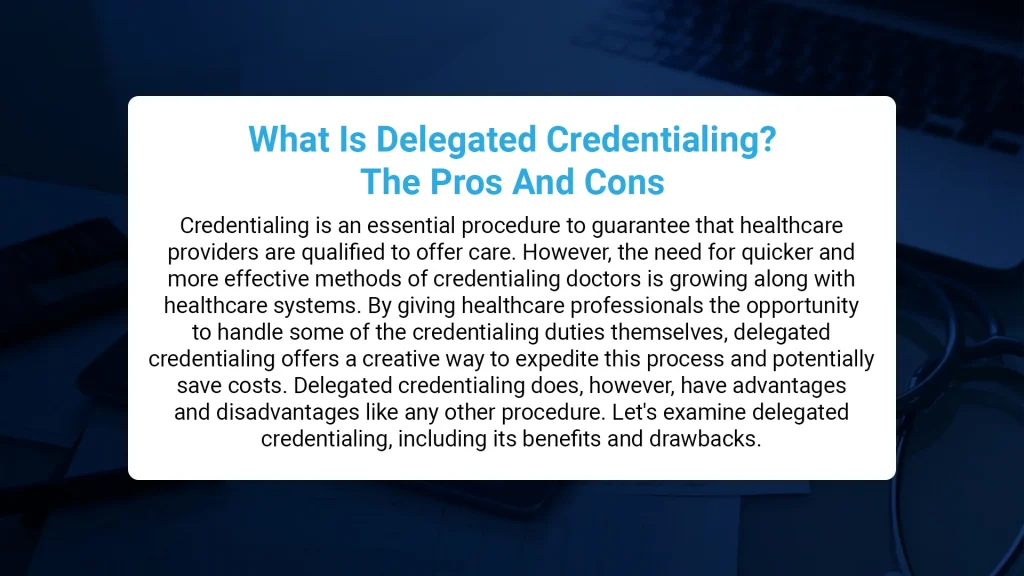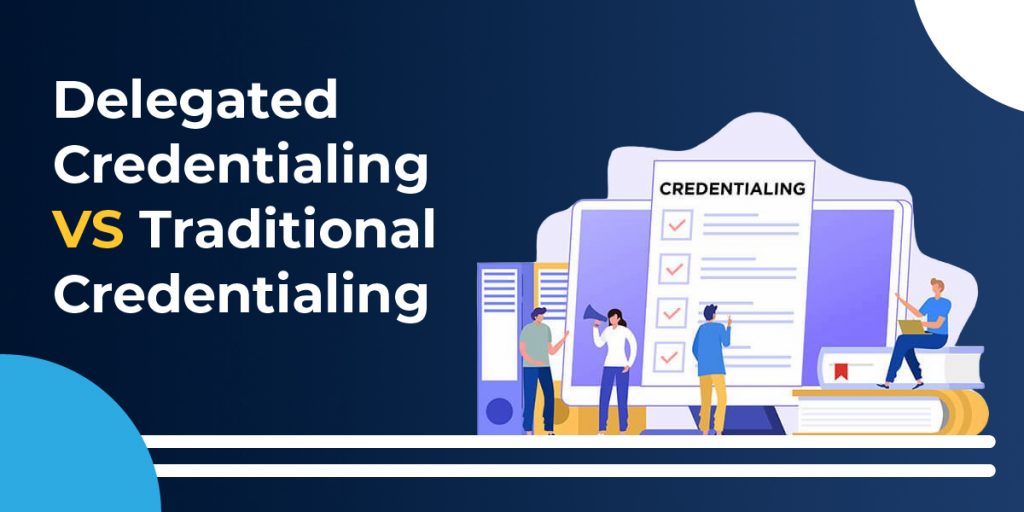Credentialing is an essential procedure to guarantee that healthcare providers are qualified to offer care. However, the need for quicker and more effective methods of credentialing doctors is growing along with healthcare systems. By giving healthcare professionals the opportunity to handle some of the credentialing duties themselves, delegated credentialing offers a creative way to expedite this process and potentially save costs. Delegated credentialing does, however, have advantages and disadvantages like any other procedure. Let’s examine delegated credentialing, including its benefits and drawbacks.

Delegated Credentialing
A system known as “delegated credentialing” allows a healthcare institution or provider to take on some of the credentialing duties that insurance companies typically perform. Large healthcare networks that use their credentialing departments are especially likely to use this method, which enables them to immediately confirm the credentials of their physicians.
Delegated Credentialing VS Traditional Credentialing

Traditional credentialing is a time-consuming and expensive process that is finished by external credentialing organizations and insurance companies. Healthcare practitioners carry out these duties through delegated credentialing, which could expedite the procedure and increase efficiency.
Important Participants in Delegated Credentialing
Healthcare Providers
Credentialing is primarily managed and verified by healthcare providers, especially major organizations. It is their duty to adhere to the guidelines and standards established by insurance.
Insurance Companies
To make sure that their credentialing rules are being followed, insurance companies keep an eye on and audit the procedure. They might conduct routine inspections to verify that the assigned entity satisfies legal and quality standards.
Credentialing Organizations
Credentialing organizations give healthcare providers the resources, support, and direction they need to keep their credentials current and accurate. In order to expedite the delegated credentialing process, they might also offer software and consulting services.
The Delegated Credentialing Process
- Initial Evaluation and Acceptance
Insurance companies perform an initial evaluation to make sure healthcare providers fulfill requirements before allowing them to handle credentialing. This entails a careful examination of the provider’s procedures and guidelines.
- Continuous Observation and Adherence
Following acceptance, the provider must continue to maintain their credentials while adhering to legal requirements. To make sure the provider maintains credentialing quality, insurance companies regularly inspect the provider.
Delegated Credentialing Benefits
- Healthcare businesses can frequently cut down on the time needed to credential new clinicians by managing credentialing internally. Providers may see patients sooner because of this speed, which also facilitates faster staff onboarding.
- Some of the costs related to employing third-party certifying bodies are eliminated with delegated credentialing. In the long run, the processing cost savings can be substantial for big healthcare systems that hire people frequently.
- Organizations can directly control the credentialing process and lessen their need for outside entities by managing it internally. More adaptability to organizational demands and deadlines results from this.
- A healthcare facility can establish standardized procedures through in-house credentialing, which improves compliance with regulations and increases uniformity across sites or departments.
- Simplified credentialing enables organizations to meet staffing demands more quickly, improving their capacity to maintain competitiveness in a changing healthcare landscape where patient access to care is essential.
Cons of Delegated Credentialing
- With more control comes more responsibility, including additional staffing, software, and management required to maintain credentialing records and stay compliant with regulations.
- The organization is accountable for accurate and thorough credentialing. Errors can result in legal liabilities, regulatory penalties, and even the loss of delegated status if audits reveal non-compliance.
- Delegated credentialing implementation necessitates an initial investment in software and processes to support frequent audits and staff training. These expenses can be too much for smaller practices.
- To retain delegated status, organizations are subject to regular audits by insurers and credentialing bodies, requiring consistent effort to ensure compliance with changing standards and regulations.
- Manual handling of credentialing can lead to data errors while maintaining consistency across departments or branches can be challenging. Software tools can help, but human oversight is still essential.
When Should You Consider Delegated Credentialing?
Delegated credentialing is worth considering for large healthcare networks or practices experiencing rapid growth, as it can reduce onboarding time and costs for new providers. Businesses that have strong compliance systems and specialized credentialing teams are well-suited to handle this internally, giving them more control and uniformity—especially when growing across several sites. Delegated credentialing can drastically cut down on patient access wait times for healthcare providers in regions where speed to market is crucial, including in underserved or competitive areas. Despite the setup’s initial cost, it provides long-term advantages, making it a wise decision for businesses with significant credentialing requirements.
Basics to know about insurance credentialing for your practice
Technology’s Role in Delegated Credentialing
- Credentialing Software Solutions: Software solutions streamline the credentialing process, providing tools for tracking and verifying credentials while maintaining compliance.
- Automation in Credentialing: Automation can reduce errors, speed up processing times, and ensure timely updates, making credentialing more efficient and reliable.
Final Thoughts
Big healthcare providers looking to boost productivity and cut costs might consider delegated credentialing as an alternative to traditional methods. However, this approach requires careful planning, ongoing oversight, and in-depth quality checks to ensure it meets standards and maintains quality. When done right, delegated credentialing can speed up the process of bringing new providers on board and help organizations grow in the fast-changing healthcare world.
